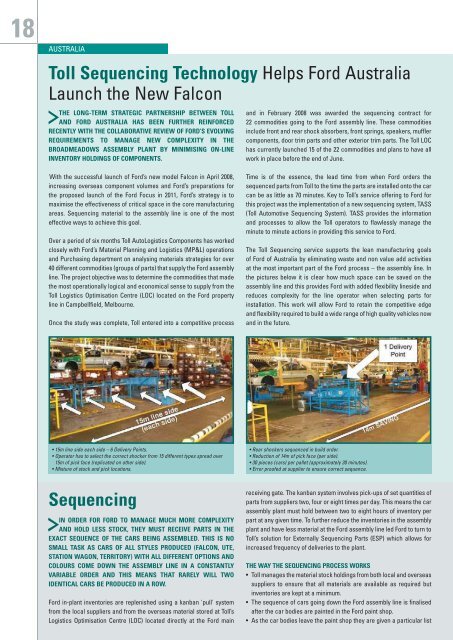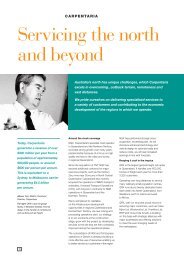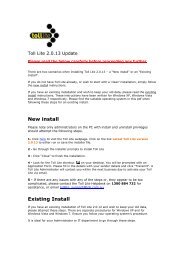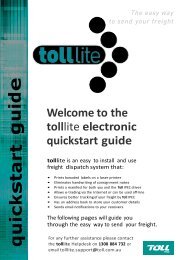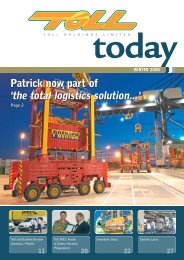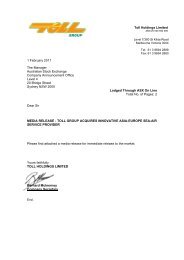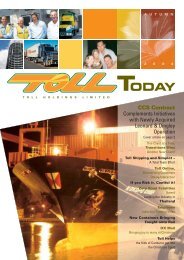PA GE Train and Ferry Whistles Blow for the Last Time - TOLL Group
PA GE Train and Ferry Whistles Blow for the Last Time - TOLL Group
PA GE Train and Ferry Whistles Blow for the Last Time - TOLL Group
Create successful ePaper yourself
Turn your PDF publications into a flip-book with our unique Google optimized e-Paper software.
18<br />
AUSTRALIA AUSTRALIA<br />
Toll Sequencing Technology Helps Ford Australia<br />
Launch <strong>the</strong> New Falcon<br />
THE LONG-TERM STRATEGIC <strong>PA</strong>RTNERSHIP BETWEEN <strong>TOLL</strong><br />
AND FORD AUSTRALIA HAS BEEN FURTHER REINFORCED<br />
RECENTLY WITH THE COLLABORATIVE REVIEW OF FORD’S EVOLVING<br />
REQUIREMENTS TO MANA<strong>GE</strong> NEW COMPLEXITY IN THE<br />
BROADMEADOWS ASSEMBLY PLANT BY MINIMISING ON-LINE<br />
INVENTORY HOLDINGS OF COMPONENTS.<br />
With <strong>the</strong> successful launch of Ford’s new model Falcon in April 2008,<br />
increasing overseas component volumes <strong>and</strong> Ford’s preparations <strong>for</strong><br />
<strong>the</strong> proposed launch of <strong>the</strong> Ford Focus in 2011, Ford’s strategy is to<br />
maximise <strong>the</strong> effectiveness of critical space in <strong>the</strong> core manufacturing<br />
areas. Sequencing material to <strong>the</strong> assembly line is one of <strong>the</strong> most<br />
effective ways to achieve this goal.<br />
Over a period of six months Toll AutoLogistics Components has worked<br />
closely with Ford’s Material Planning <strong>and</strong> Logistics (MP&L) operations<br />
<strong>and</strong> Purchasing department on analysing materials strategies <strong>for</strong> over<br />
40 different commodities (groups of parts) that supply <strong>the</strong> Ford assembly<br />
line. The project objective was to determine <strong>the</strong> commodities that made<br />
<strong>the</strong> most operationally logical <strong>and</strong> economical sense to supply from <strong>the</strong><br />
Toll Logistics Optimisation Centre (LOC) located on <strong>the</strong> Ford property<br />
line in Campbellfield, Melbourne.<br />
Once <strong>the</strong> study was complete, Toll entered into a competitive process<br />
15m line side each side – 6 Delivery Points.<br />
Operator has to select <strong>the</strong> correct shocker from 15 different types spread over<br />
15m of pick face (replicated on o<strong>the</strong>r side).<br />
Mixture of stock <strong>and</strong> pick locations.<br />
Sequencing<br />
IN ORDER FOR FORD TO MANA<strong>GE</strong> MUCH MORE COMPLEXITY<br />
AND HOLD LESS STOCK, THEY MUST RECEIVE <strong>PA</strong>RTS IN THE<br />
EXACT SEQUENCE OF THE CARS BEING ASSEMBLED. THIS IS NO<br />
SMALL TASK AS CARS OF ALL STYLES PRODUCED (FALCON, UTE,<br />
STATION WAGON, TERRITORY) WITH ALL DIFFERENT OPTIONS AND<br />
COLOURS COME DOWN THE ASSEMBLY LINE IN A CONSTANTLY<br />
VARIABLE ORDER AND THIS MEANS THAT RARELY WILL TWO<br />
IDENTICAL CARS BE PRODUCED IN A ROW.<br />
Ford in-plant inventories are replenished using a kanban 'pull' system<br />
from <strong>the</strong> local suppliers <strong>and</strong> from <strong>the</strong> overseas material stored at Toll’s<br />
Logistics Optimisation Centre (LOC) located directly at <strong>the</strong> Ford main<br />
<strong>and</strong> in February 2008 was awarded <strong>the</strong> sequencing contract <strong>for</strong><br />
22 commodities going to <strong>the</strong> Ford assembly line. These commodities<br />
include front <strong>and</strong> rear shock absorbers, front springs, speakers, muffler<br />
components, door trim parts <strong>and</strong> o<strong>the</strong>r exterior trim parts. The Toll LOC<br />
has currently launched 15 of <strong>the</strong> 22 commodities <strong>and</strong> plans to have all<br />
work in place be<strong>for</strong>e <strong>the</strong> end of June.<br />
<strong>Time</strong> is of <strong>the</strong> essence, <strong>the</strong> lead time from when Ford orders <strong>the</strong><br />
sequenced parts from Toll to <strong>the</strong> time <strong>the</strong> parts are installed onto <strong>the</strong> car<br />
can be as little as 70 minutes. Key to Toll’s service offering to Ford <strong>for</strong><br />
this project was <strong>the</strong> implementation of a new sequencing system, TASS<br />
(Toll Automotive Sequencing System). TASS provides <strong>the</strong> in<strong>for</strong>mation<br />
<strong>and</strong> processes to allow <strong>the</strong> Toll operators to flawlessly manage <strong>the</strong><br />
minute to minute actions in providing this service to Ford.<br />
The Toll Sequencing service supports <strong>the</strong> lean manufacturing goals<br />
of Ford of Australia by eliminating waste <strong>and</strong> non value add activities<br />
at <strong>the</strong> most important part of <strong>the</strong> Ford process – <strong>the</strong> assembly line. In<br />
<strong>the</strong> pictures below it is clear how much space can be saved on <strong>the</strong><br />
assembly line <strong>and</strong> this provides Ford with added flexibility lineside <strong>and</strong><br />
reduces complexity <strong>for</strong> <strong>the</strong> line operator when selecting parts <strong>for</strong><br />
installation. This work will allow Ford to retain <strong>the</strong> competitive edge<br />
<strong>and</strong> flexibility required to build a wide range of high quality vehicles now<br />
<strong>and</strong> in <strong>the</strong> future.<br />
Rear shockers sequenced in build order.<br />
Reduction of 14m of pick face (per side).<br />
30 pieces (cars) per pallet (approximately 30 minutes).<br />
Error proofed at supplier to ensure correct sequence.<br />
receiving gate. The kanban system involves pick-ups of set quantities of<br />
parts from suppliers two, four or eight times per day. This means <strong>the</strong> car<br />
assembly plant must hold between two to eight hours of inventory per<br />
part at any given time. To fur<strong>the</strong>r reduce <strong>the</strong> inventories in <strong>the</strong> assembly<br />
plant <strong>and</strong> have less material at <strong>the</strong> Ford assembly line led Ford to turn to<br />
Toll’s solution <strong>for</strong> Externally Sequencing Parts (ESP) which allows <strong>for</strong><br />
increased frequency of deliveries to <strong>the</strong> plant.<br />
THE WAY THE SEQUENCING PROCESS WORKS<br />
Toll manages <strong>the</strong> material stock holdings from both local <strong>and</strong> overseas<br />
suppliers to ensure that all materials are available as required but<br />
inventories are kept at a minimum.<br />
The sequence of cars going down <strong>the</strong> Ford assembly line is finalised<br />
after <strong>the</strong> car bodies are painted in <strong>the</strong> Ford paint shop.<br />
As <strong>the</strong> car bodies leave <strong>the</strong> paint shop <strong>the</strong>y are given a particular list<br />
Toll Automated Sequencing System<br />
WITH SUCH A TIME CRITICAL OPERATION, KEY TO <strong>TOLL</strong>’S<br />
SERVICE OFFERING TO FORD FOR THIS PROJECT WAS THE<br />
IMPLEMENTATION OF A NEW, WORLD CLASS, SEQUENCING SYSTEM,<br />
TASS. TASS PROVIDES THE HEARTBEAT INFORMATION REQUIRED<br />
TO ALLOW THE <strong>TOLL</strong> TEAM TO CORRECTLY AND EFFICIENTLY PICK<br />
THE CORRECT MATERIAL, CONFIRM THAT IT IS RIGHT AND THEN<br />
MANA<strong>GE</strong> THE MOVEMENT OF THE SEQUENCED <strong>PA</strong>RTS TO THE<br />
INSTALL POINT IN THE ASSEMBLY PLANT.<br />
RESEARCH AND COLLABORATION PHASE<br />
Key managers from Toll AutoLogistics travelled to Ford Plants in Mexico<br />
<strong>and</strong> <strong>the</strong> US to benchmark world’s best practice sequencing operations.<br />
Mark Skalin (National Operations Manager) <strong>and</strong> Patrick Kashani<br />
(National IT Manager) visited Ford Dearborn Truck <strong>and</strong> Ford Hermosillo<br />
to review <strong>the</strong> system, process <strong>and</strong> design of existing outsourced<br />
operations.<br />
TASS operating parameters were <strong>the</strong>n benchmarked against <strong>the</strong><br />
st<strong>and</strong>ard of o<strong>the</strong>r sequencing operations <strong>and</strong> <strong>the</strong> final specifications<br />
were set.<br />
IT DEVELOPMENT AND EXECUTION PHASE<br />
Development <strong>and</strong> Customisation of <strong>the</strong> TASS software began in February<br />
this year <strong>and</strong> went live <strong>and</strong> operational in March 2008. Through <strong>the</strong><br />
development stage <strong>the</strong> key process objectives were to ensure continuous<br />
<strong>and</strong> flawless operations. This meant that <strong>the</strong> system would need to be fully<br />
error proofed to ensure that <strong>the</strong> team members could not make a mistake<br />
<strong>and</strong> place parts in <strong>the</strong> wrong order. Diligent process design including<br />
barcode scanning of <strong>the</strong> components <strong>and</strong> proper material layouts has<br />
ensured <strong>the</strong> quality of service provided to Ford is of <strong>the</strong> highest level.<br />
Real <strong>Time</strong> Tracking via TASS web screen <strong>for</strong> visibility of part status includes colour<br />
alerts.<br />
of requirements <strong>for</strong> components <strong>and</strong> this identifies <strong>the</strong> exact list<br />
of options <strong>for</strong> each individual car order.<br />
Once <strong>the</strong> car body has had been assigned an order <strong>the</strong> in<strong>for</strong>mation <strong>for</strong><br />
that car <strong>and</strong> <strong>the</strong> sequence <strong>the</strong> car is in relative to all <strong>the</strong> o<strong>the</strong>r cars is<br />
scanned into <strong>the</strong> Ford IT system which <strong>the</strong>n communicates to <strong>the</strong> Toll<br />
TASS System.<br />
TASS breaks down <strong>the</strong> order from Ford <strong>and</strong> communicates to <strong>the</strong> Toll<br />
sequencing operators <strong>the</strong> exact next parts to ship to Ford via h<strong>and</strong><br />
held RF scanners.<br />
All parts are picked <strong>and</strong> TASS aids <strong>the</strong> Toll sequence operator to error<br />
proof <strong>the</strong> process by assisting to check <strong>the</strong> parts in each stillage <strong>and</strong><br />
<strong>the</strong>n ensure that each stillage is sent to Ford in <strong>the</strong> correct order.<br />
TASS continuously monitors <strong>the</strong> movements of <strong>the</strong> Ford assembly line<br />
to help Toll operations manage <strong>the</strong> exact amount of material at Ford<br />
– never too little nor too much.<br />
The o<strong>the</strong>r key objective is to ensure that <strong>the</strong> systems operations<br />
have 100 percent uptime. Failsafes <strong>and</strong> redundant process include<br />
separate systems test environments, completely duplicated hardware<br />
arrangements, completely redundant network connections to Ford, <strong>and</strong><br />
emergency electrical generators with uninterruptible power supplies.<br />
Above all, <strong>the</strong> key to <strong>the</strong> integrity <strong>and</strong> accuracy of <strong>the</strong> operation is <strong>the</strong><br />
people who use <strong>the</strong> system each day. Great ef<strong>for</strong>ts were taken with this<br />
new team to ensure that <strong>the</strong> processes were intuitive <strong>and</strong> easy to use.<br />
Once <strong>the</strong> processes were set all team members were taught how to use<br />
<strong>the</strong> system <strong>and</strong> were given extensive h<strong>and</strong>s on training <strong>and</strong> cross<br />
training on different parts of <strong>the</strong> operation. So far <strong>the</strong> team has excelled<br />
in <strong>the</strong> use of <strong>the</strong> system <strong>and</strong> will be able to support new members as <strong>the</strong><br />
team grows.<br />
Comm<strong>and</strong> <strong>and</strong> Control Centre managing <strong>the</strong> operations within <strong>the</strong> LOC.<br />
TASS – THE SYSTEM<br />
Provides production control <strong>and</strong> direction <strong>for</strong> sequencing / picking,<br />
container movement <strong>and</strong> shipping.<br />
Ford broadcasts real-time orders, in job number order (sequence)<br />
which include all <strong>the</strong> component requirements.<br />
TASS organises <strong>the</strong> parts in<strong>for</strong>mation about <strong>the</strong> part sequence into<br />
outbound shipping stillages.<br />
Orders are sent by TASS to sequence operators via portable RF<br />
scanning to pick <strong>the</strong> parts <strong>and</strong> load into <strong>the</strong> stillages in <strong>the</strong> correct<br />
sequence.<br />
TASS prints pick list if applicable <strong>and</strong> also prints run sheets <strong>and</strong><br />
stillage labels <strong>for</strong> material h<strong>and</strong>lers.<br />
This system provides tracking of all transactions from RF scanners,<br />
including error messages generated.<br />
The goal of TASS is to provide an error proofing system which<br />
prevents customer defects <strong>and</strong> / or downtime.<br />
All transactions are posted in real-time.<br />
Ultimately TASS simplifies assembly activity within <strong>the</strong> plant by<br />
increasing ease of fitment <strong>for</strong> Ford.<br />
A sequencing operator wears <strong>the</strong> latest arm worn Mobile Data Terminal with finger<br />
RF scanner to provide freedom of movement <strong>for</strong> picking <strong>and</strong> scanning larger parts.<br />
19<br />
<strong>TOLL</strong> TODAY JUNE – AUGUST 2008


